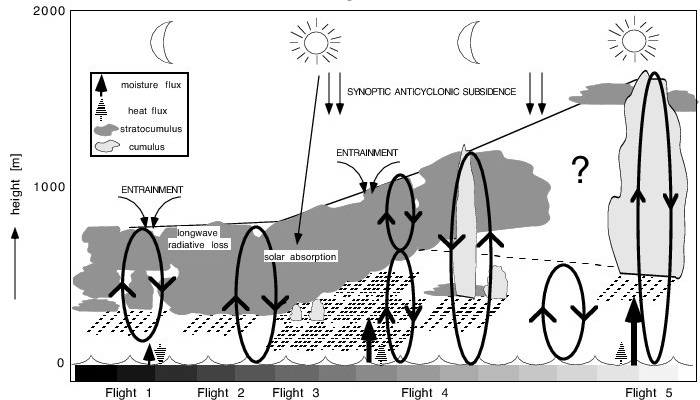Euclipse ASTEX Lagrangian model intercomparison case
Introduction
The Atlantic Stratocumulus to Cumulus Transition Experiment (ASTEX) field campaign was conducted in June 1992 near the Azores (Albrecht et al. 1995). In the First Lagrangian of ASTEX five aircraft flights were made by the NCAR Electra and UKMO C130 aircraft (Bretherton and Pincus, 1995; Bretherton et al., 1995; De Roode and Duynkerke, 1997). Except for the last flight, these flights all took place in the same air mass which was being advected equatorwards. This experiment lasted about two days during which a transition from solid stratocumulus to cumulus penetrating thin and broken stratocumulus above was observed. Peter Duynkerke used the second flight ("A209") to set up a GCSS stratocumulus modeling intercomparison case that was based on ASTEX observations. As part of the EUCREM project data collected during the third flight ("RF06") was used to design another modeling incomparison case (Duynkerke et al. 1999). These two intercomparison cases were nearly identical except for the inversion jumps of temperature and moisture. The entrainment rates diagnosed from the LES modeling results showed that the weaker inversion stability caused larger entrainment rates during the third flight. Note that the control runs were made without drizzle. Recent results show that cloud droplet sedimentation and drizzle act to decrease the entrainment rate (Ackerman et al. 2004.)
Chris Bretherton organized a full ASTEX First Lagrangian modeling intercomparison study which was simulated with single-column model versions of weather forecast models (Bretherton et al. 1999). The models all predicted the observed deepening and decoupling of the boundary layer quite well, with cumulus cloud evolution and thinning of the overlying stratocumulus. These models all appeared capable of predicting transitions between cloud and boundary-layer types with some skill. The models also produced realistic drizzle rates, but there were substantial quantitative differences in the cloud cover and liquid water path between models. This case was not run with LES models. At the time of this full ASTEX Lagrangian intercomparison study supercomputers were just not powerful enough to allow detailed 3D simulations for a period of 48 hours.
The new ASTEX intercomparison case can be considered as a hybrid version of Peter Duynkerke's GCSS A209 and Chris Bretherton's First Lagrangian intercomparison cases and has been set up with assistance by Johan van der Dussen (TU Delft). Small differences are made to the Bretherton case concerning time-varying geostrophic wind velocities and the effect of cirrus clouds on downwelling radiation is neglected. Furthermore, a constant surface pressure, latitude and longitude are used. The A209 initial vertical profiles will be used for the new intercomparison case, whereas the large-scale forcing is adapted from Bretherton's data set. This means that the first flight of the ASTEX First Lagrangian will not be modeled. A motivation for this choice is that it facilitates a comparison between data from the previous intercomparison studies with results that will be obtained from revised large-eddy simulation models and single-column model versions of weather forecast models. For example, important physics routines that have been added to many LES models are microphysics and radiation.
Research aims and science questions
- The effect of drizzle and cloud droplet sedimentation on the entrainment rate during the First Lagrangian of ASTEX. Note that results of the previous non-drizzling ASTEX stratocumulus cases have been used for the development of entrainment parameterizations. Do they still hold if there is drizzle?
- How do the cloud liquid water path and cloud cover evolve? Lock (2009) presents a parameter that well explains the cloud cover near the buoyancy reversal regime and should be considered as a good indicator predicting the transition of solid stratocumulus to scattered shallow cumulus clouds.
- Length scale analyses and the effect of subdomain sizes on second-order moments. LES modelers are asked to run the simulation on a large horizontal domain and to store 3D fields. Many operational regional weather forecast models use a horizontal grid resolution of the order of 1~2 km. This means that some part of the turbulent flux transport will be resolved. The question is how large this contribution is to the total flux. We would like to collect statistics that are needed for parameterization schemes that combine both eddy-diffusivity and mass-flux parameterizations to compute vertical fluxes (Lappen and Randall,2001; Soares et al., 2004) .
Schedule
In September 2010 a Euclipse/GCSS BLCWG meeting was organized during which results obtained from the first round were discussed. It was decided to slightly modify case and to organize a second round. The main change concerns a slighly different large-scale divergence rate. New participants are welcome to join. We would like to receive new results before 1 February 2011. The ASTEX simulation results should be emailed to s.r.deroode"*"tudelft.nl and to irina.sandu"*"zmaw.de ("*"=@) for the composite case. In any case, please let us know if you are interested to run the intercomparison cases so we can keep you updated.
Some preliminary results
The LES results obtained with DALES are presented in a paper that was presented at the 19th Symp. Bound.-Layers and Turbulence, Keystone, August 2010.
Acknowledgements
Irina Sandu's help in setting up this case is greatly appreciated.

Schematic of the ASTEX First Lagrangian